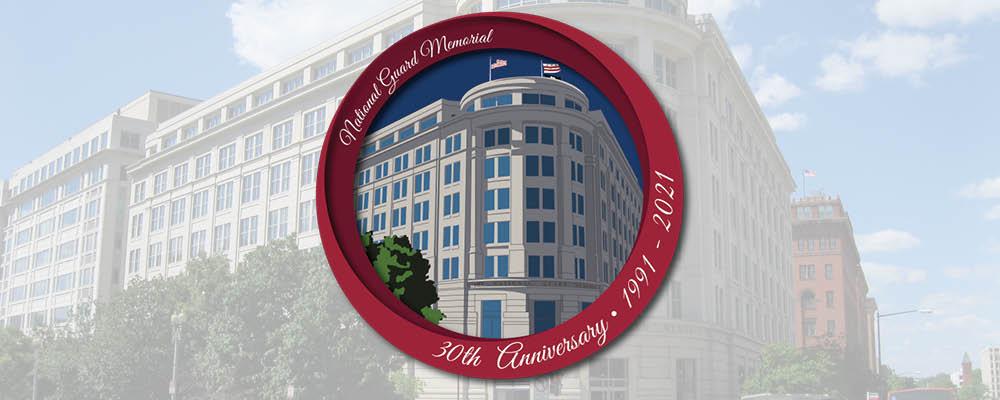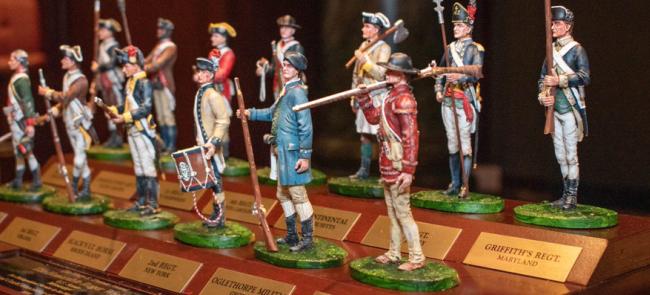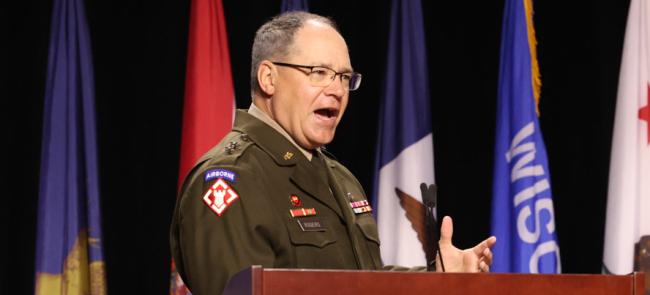
A New Milestone
The National Guard Memorial, the NGAUS headquarters in Washington, D.C., is now 30 years old.
That’s hard to believe for those of us who helped open the building in 1991. Time does fly. The structure has now stood longer on the same site than the original memorial, which is also hard to comprehend. The association tore down the first building in 1988.
NGAUS leaders constructed the original in the late 1950s, fulfilling the vision of Maj. Gen. Ellard A. Walsh of Minnesota, the longtime association president who believed Guardsmen deserved a memorial in Washington and the association needed a visible presence near the Capitol.
Completed in spring 1959, the original was a marble, steel and glass structure set back from Massachusetts Avenue. The heart of the building was three floors. It included a reception room, a library, staff offices and meeting rooms.
Guests entered the building through the large, two-story Hall of States, featuring the flags of every state, Puerto Rico and the District of Columbia. The staff typically used a door from a small, fenced parking lot in the rear.
The original building served the association well. It was a good place to work when I arrived on the job in 1981. But age and changing times quickly caught up. By 1985, the staff had grown and no longer fit the workspace. The structure also needed repairs.
After reviewing their options, NGAUS leaders in 1988 decided to tear down the first memorial and construct a larger, grander building. The new structure would have more room for the staff, several floors of leasable office space and an underground garage. During construction, the staff would work out of the District of Columbia Armory across town.
The price tag was steep, roughly $30 million; however, a commercial developer would obtain the construction loan and manage the commercial portion of the building for a 45% stake in the venture.
Everything was set, but the decision wasn’t universally popular. One day as I was preparing to move out of my office, a retired Guard major general burst in nearly in tears. He had flown up from Dallas to take one last look at the structure he helped raise money to build.
To many others, it was a great plan. That is until 1990 when the association’s partner unexpectedly fell into bankruptcy. NGAUS would have to take on roles it didn’t anticipate — bill payer and landlord.
We moved back into the new building in January 1991.
It was a “soft opening.” The bottom two floors are the association’s space, and they were mostly complete, but significant work remained on the upper floors.
It was also a quiet opening. Guard leaders were focused on the start of Operation Desert Storm, which involved more than 75,000 Guard soldiers and airmen. The association waited until September to formally dedicate the memorial. Vice President Dan Quayle, a former Indiana Army Guardsman, provided the keynote.
Entry to the NGAUS portion of the building is through the Grand Foyer. The aptly named lobby features a high ceiling, a marble floor and walls, and an 8-foot bronze statue of a colonial minuteman. The figure is answering the call — his right hand clutches his musket while his left is off the plowshare.
Down a flight of steps is the first floor. It includes a research library, the National Guard Memorial Museum and the new two-floor Hall of States, which has hosted two presidents and countless members of Congress, governors and four-stars.
Upstairs from the Grand Foyer is the second floor, which contains most of the staff officers and the G.V. “Sonny” Montgomery Room, where the association board of directors meets three times a year. Montgomery was known as Mr. National Guard during his 15 terms in Congress (1967-1997) for his Guard support. He was also a major general in the Mississippi Army Guard.
The leasable office space is accessible via a separate entrance. The largest current tenant is the National Railroad Passenger Corporation, better known as Amtrak, which occupies three full floors.
NGAUS struggled mightily with the construction loan for much of the 1990s. We cut expenses by reducing staff and eliminating all but essential functions. Meanwhile, membership dues were increased. Selling the memorial was considered, but rejected.
Consistent full occupancy of six floors of office space and some wise investing eventually steadied the situation. The association was able to replace high-interest, short-term loans with a mortgage, but the monthly note remained high.
Then fortunes reversed. Invested NGAUS reserves rode the historic gains on Wall Street that followed the 2008 recession. In 2013, the association actually paid off the mortgage early.
I’m confident that NGAUS is better off with the current building, notwithstanding the financial perils the association initially faced. It’s aging gracefully and is now worth close to three times what it cost to build, in addition to its worth as a powerful symbol of Guard strength in the nation’s capital.
There aren’t many, like retired Maj. Gen. Elmer L. “Lew” Stephens, who long for the old.
I sure don’t. I hated that little parking lot.



